-
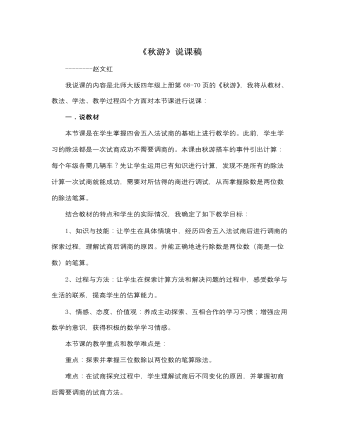
北师大版小学数学四年级上册《秋游》说课稿
我说课的内容是北师大版四年级上册第68-70页的《秋游》,我将从教材、教法、学法、教学过程四个方面对本节课进行说课:一.说教材本节课是在学生掌握四舍五入法试商的基础上进行教学的。此前,学生学习的除法都是一次试商成功不需要调商的。本课由秋游搭车的事件引出计算:每个年级各需几辆车?先让学生运用已有知识进行计算,发现不是所有的除法计算一次试商就能成功,需要对所估得的商进行调试,从而掌握除数是两位数的除法笔算。结合教材的特点和学生的实际情况,我确定了如下教学目标:1、知识与技能:让学生在具体情境中,经历四舍五入法试商后进行调商的探索过程,理解试商后调商的原因。并能正确地进行除数是两位数(商是一位数)的笔算。2、过程与方法:让学生在探索计算方法和解决问题的过程中,感受数学与生活的联系,提高学生的估算能力。
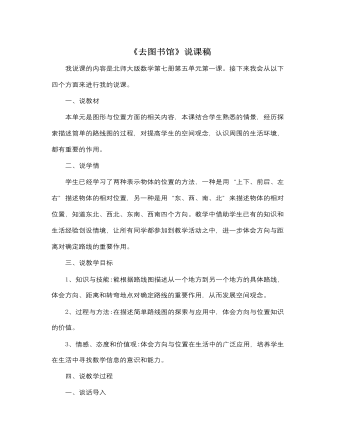
北师大版小学数学四年级上册《去图书馆》说课稿
一、说教材本单元是图形与位置方面的相关内容,本课结合学生熟悉的情景,经历探索描述简单的路线图的过程,对提高学生的空间观念,认识周围的生活环境,都有重要的作用。二、说学情学生已经学习了两种表示物体的位置的方法,一种是用“上下、前后、左右”描述物体的相对位置,另一种是用“东、西、南、北”来描述物体的相对位置,知道东北、西北、东南、西南四个方向。教学中借助学生已有的知识和生活经验创设情境,让所有同学都参加到教学活动之中,进一步体会方向与距离对确定路线的重要作用。三、说教学目标1、知识与技能:能根据路线图描述从一个地方到另一个地方的具体路线,体会方向、距离和转弯地点对确定路线的重要作用,从而发展空间观念。2、过程与方法:在描述简单路线图的探索与应用中,体会方向与位置知识的价值。3、情感、态度和价值观:体会方向与位置在生活中的广泛应用,培养学生在生活中寻找数学信息的意识和能力。
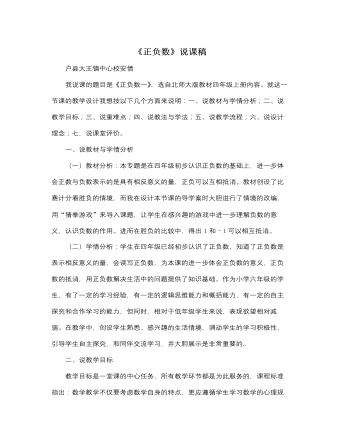
北师大版小学数学四年级上册《正负数》说课稿
二、说教学目标教学目标是一堂课的中心任务,所有教学环节都是为此服务的,课程标准指出:数学教学不仅要考虑数学自身的特点,更应遵循学生学习数学的心理规律??使学生获得对数学理解的同时,在思维能力、情感态度与价值观等方面都得到进步和发展。根据这一要求和本节教学内容,并结合学生的实际情况,本节课我确定如下学习目标:1、知识与技能在熟悉的生活情景中,进一步体会负数的意义;会用负数表示一些日常生活中的问题,知道正负可以相互抵消。2、过程与方法本节课以小组合作学习为主,让学生利用导学案自学,再对学、群学,最后在班里进行展示。整节课都是学生自主学习,积极探索的一个过程。3、情感、态度与价值观经历独学、交流、合作、展示等一系列活动,通过生生、师生互动获得良好的情感体验,同时让学生感受到了数学在生活中的应用。依据这样的教学目标,再结合学生的年龄特点,我运用了浅显易懂的儿童语言制定了导学案上的学习目标。
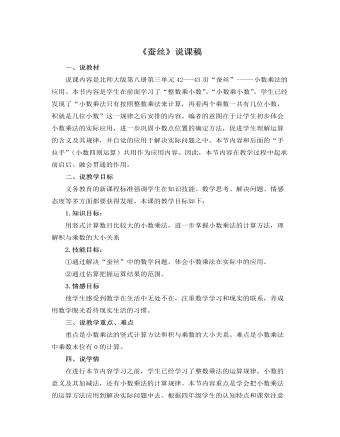
北师大版小学数学四年级下册《蚕丝》说课稿
三、说教学重点、难点重点是小数乘法的竖式计算方法和积与乘数的大小关系。难点是小数乘法中乘数末位有0的计算。四、说学情在进行本节内容学习之前,学生已经学习了整数乘法的运算规律,小数的意义及其加减法,还有小数乘法的计算规律。本节内容重点是学会把小数乘法的运算方法应用到解决实际问题中去。根据四年级学生的认知特点和课堂注意力时间有限的特点,在教学中一定要提高课堂效率五、说教法、学法在本课教学中,我采取的教学方法是:1.通过复习,回顾计算规律,并把它应用到竖式中去。2.情境展示,把数学问题直接放在实际问题中来学习并解决。3.解决问题时采用自主探索、独立思考和小组合作交流的学习方式。通过这些教学法激发学生学习的积极性和主动性,引导学生把学到的规律应用到现实生活中来解决实际问题。六、说教学过程(一)举例说明积的小数位数与乘数小数位数的关系。通过比眼力,做一做,复习前一节课所学内容,为本节课打下基础。
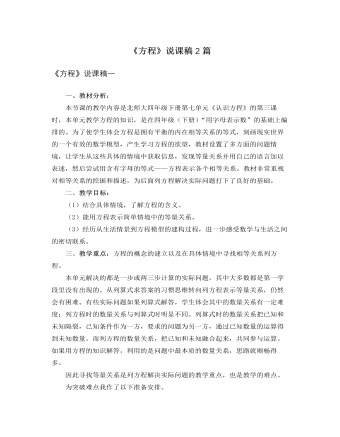
北师大版小学数学四年级下册《方程》说课稿2篇
3、变换角度,深入思考第三幅情境图隐含着多样的等量关系,也正是引发学生数学思考的最佳情境。根据学生认识的深入程度,可适当让学生体会到等式的“值等”和“意等”,并放手让学生探究,根据不同的认识找到不同的等量关系,列出等量关系不同的同解方程。在教学中,先引导孩子发现情境中的基本相等关系:2瓶水的水量+一杯水的水量=一壶水的水量,并且列出等式2z+200=2000,在此基础上,再引导孩子发现其他的等量关系。在这一过程中,充分激发孩子探求知识的欲望,调动孩子思考的主动性和灵活性,从而找到多样化的等量关系,并进一步提高孩子解决数学问题的能力。4、建立概念,判断巩固在前面教学的基础上总结、抽象出方程的含义。通过三道例题的简洁数学式子表达,让小组合作寻找他们的共同特点,从而建立方程的概念。“含有未知数”与“等式”是方程概念的两点最重要的内涵。并通过“练一练”让学生直接找出方程。
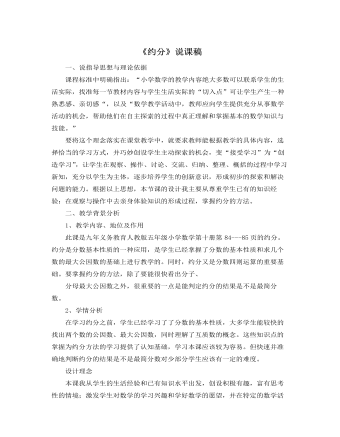
北师大版小学数学五年级上册《约分》说课稿
课程标准中明确指出:“小学数学的教学内容绝大多数可以联系学生的生活实际,找准每一节教材内容与学生生活实际的“切入点”可让学生产生一种熟悉感、亲切感“,以及“数学教学活动中,教师应向学生提供充分从事数学活动的机会,帮助他们在自主探索的过程中真正理解和掌握基本的数学知识与技能。”要将这个理念落实在课堂教学中,就要求教师能根据教学的具体内容,选择恰当的学习方式,并巧妙创设学生主动探索的机会,变“接受学习”为“创造学习”,让学生在观察、操作、讨论、交流、归纳、整理、概括的过程中学习新知,充分以学生为主体,逐步培养学生的创新意识,形成初步的探索和解决问题的能力。根据以上思想,本节课的设计我主要从尊重学生已有的知识经验;在观察与操作中去亲身体验知识的形成过程,掌握约分的方法。
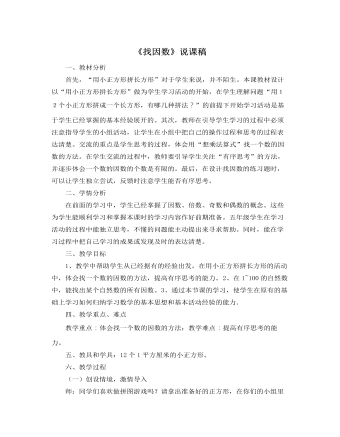
北师大版小学数学五年级上册《找因数》说课稿
【设计意图:让学生在操作、探索的基础上,组内交流想法,再在班内交流汇报,让学生的语言得到相互交流、碰撞,从而不断激发学生的思维火花。】师:你能把这些摆法用算式写出来吗?(学生独立写出算式并汇报)依学生汇报板书:1×12=122×6=1212×1=126×2=123×4=124×3=12师:请同学们观察一下,哪两道算式的因数一样?学生观察算式,找出因数一样的算式。师:那么,这6个算式最少能用几种算式表示出来?引导学生说出能用3种方法表示,这三种方法是:1×12=122×6=123×4=12,并指明算式一样时选择其中一种说出来。板书:12=1×12=2×6=3×4师:同学们观察一下,12的因数有哪几个?(学生说出12的因数有:1、12、2、6、3、4。)师:拼长方形与找因数有什么关系呢?(指名学生说一说)师:根据刚才的操作交流,请同学们说一说怎样找一个数的因数呢?(学生思考片刻后汇报,可以组内交流。)引导学生说出:用乘法思路想,看哪两个数相乘得12,然后一对一对找出来。
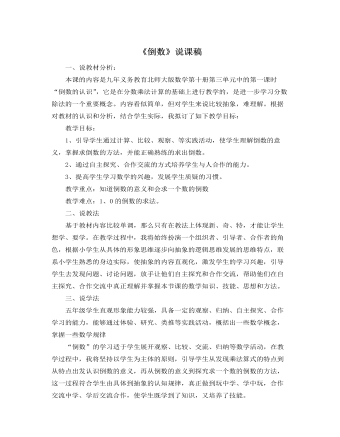
北师大版小学数学五年级下册《倒数》说课稿
教学目标:1、引导学生通过计算、比较、观察、等实践活动,使学生理解倒数的意义,掌握求倒数的方法,并能正确熟练的求出倒数。2、通过自主探究、合作交流的方式培养学生与人合作的能力。3、提高学生学习数学的兴趣,发展学生质疑的习惯。教学重点:知道倒数的意义和会求一个数的倒数教学难点:1、0的倒数的求法。二、说教法基于教材内容比较单调,那么只有在教法上体现新、奇、特,才能让学生想学、要学。在教学过程中,我将始终扮演一个组织者、引导者、合作者的角色,根据小学生从具体的形象思维逐步向抽象的逻辑思维发展的思维特点,联系小学生熟悉的身边实际,使抽象的内容直观化,激发学生的学习兴趣,引导学生去发现问题、讨论问题,放手让他们自主探究和合作交流,帮助他们在自主探究、合作交流中真正理解并掌握本节课的数学知识、技能、思想和方法。
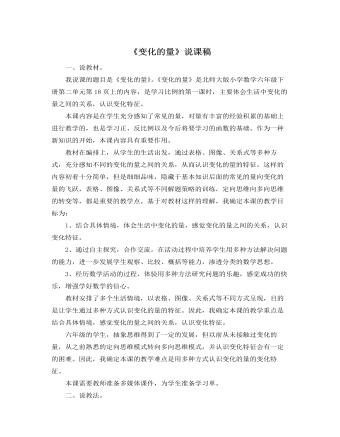
北师大版小学数学六年级下册《变化的量》说课稿
1、结合具体情境,体会生活中变化的量,感觉变化的量之间的关系,认识变化特征。2、通过自主探究,合作交流,在活动过程中培养学生用多种方法解决问题的能力,进一步发展学生观察、比较、概括等能力,渗透分类的数学思想。3、经历数学活动的过程,体验用多种方法研究问题的乐趣,感觉成功的快乐,增强学好数学的信心。教材安排了多个生活情境,以表格、图像、关系式等不同方式呈现,目的是让学生通过多种方式认识变化的量的特征。因此,我确定本课的教学重点是结合具体情境,感觉变化的量之间的关系,认识变化特征。六年级的学生,抽象思维得到了一定的发展,但以前从未接触过变化的量,从之前熟悉的定向思维模式转向多向思维模式,并认识变化特征会有一定的困难。因此,我确定本课的教学难点是用多种方式认识变化的量的变化特征。本课需要教师准备多媒体课件,为学生准备学习单。
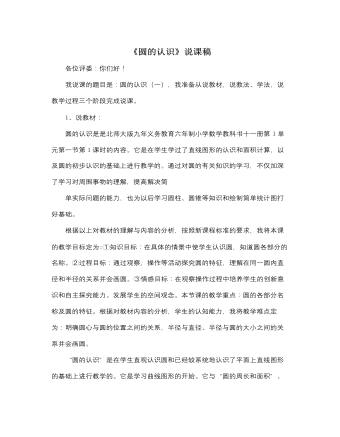
北师大版小学数学六年级上册《圆的认识》说课稿
④联系生活实际解决身边的问题,让同学初步感受数学与日常生活的密切联系,体验数学的应用,促进学生的发展。接下来,我再具体谈一谈这堂课的教学过程。3、说教学过程第一环节:创设情境,激qing导入。同学们你们看屏幕上的是什么?(出示图片)那么自行车车轮是什么形状的?为什么车轮要设计成圆形?这里面有什么奥妙呢?学了今天的内容大家就会明白的。这节课我们就走进圆的世界去探寻其中的奥妙。板书课题:圆的认识设计意图:通过生活中实际例子引入课题,一方面引起学生的学习兴趣,另一方面为学习新知识做了铺垫,从思想上吸引了学生主动参与学习的活动。这一环节的设计,主要是想体现数学就在我们的身边,从而激发学生学习的兴趣及学习的积极性。
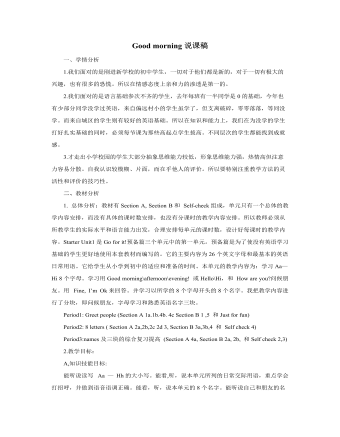
人教版新目标初中英语七年级上册Good morning说课稿
1.课堂活动中的竞赛制:以记奖评优的形式无声的评价每一个活动,包括个体和小群体。在第一课时评最佳演员和导演奖,第二课时评最佳团体奖,既节约时间又明确有效。使学生能提高语言质量,增强参与意识,提高学习兴趣。2. 教师课堂上语言、表情激励制:在课堂活动中教师要乐于 、善于用激励性语言。从good, super, smart, excellent , great ,wonderful等,用微笑,皱眉,摇头、点头等身体语言对于学生的评价是方便又有效的途径。3.课后作业评价:口头作业在第二天课堂上表演,接受全体同学的评价。笔头作业有教师批阅,以评语的方式出现。优秀作业予以展出或交流。积极地肯定和鼓励学生是我们评价的重要目的之一。4.单元结束后综合性评价:除了笔试以外,也可以根据学生实际开展丰富的活动,如:调查报告、小品表演、专题演讲等。
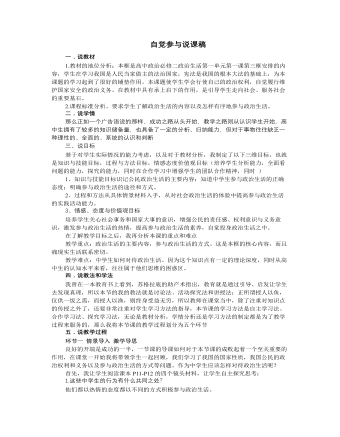
人教版高中政治必修2自觉参与说课稿
1.必须明确政治生活的作用 (政治生活与经济生活、文化生活是相辅相成的。政治生活直接影响到人民民主的实现程度,影响全体人民利益,也会影响我们的经济生活、文化生活。)2.需要学习政治知识 (5个有助于)3.需要参加政治实践活动。 (参加政治实践的途径;参加政治实践的意义)(通过情景问题,形成学生如何参与政治生活的方法;通过解决问题,培养学生解决问题的能力和发散思维的能力。)环节四 课堂小结 巩固知识本节课我采用线索性的板书,整个知识结构一目了然,为了充分发挥学生在课堂的主体地位,我将课堂小结交由学生完成,请学生根据课堂学习的内容,结合我的板书设计来进行小结,以此来帮助教师在第一时间掌握学生学习信息的反馈,同时培养学生归纳分析能力、概括能力。

人教版高中英语必修1English around the world说课稿
(3)v. 给:提出;展现,显现present sb. with sth. ; present sth. to sb. 把. . 交给;颁发;授予present sth. (for sth. )/present sth. to sb. e. g. Om his birthday, his friends presented him a collection of stamps. 在他生日时,他的朋友们送给他一套邮票作为礼物。The sword was presented by the family to the museum. 这家人把宝剑捐赠给了博物馆。The committee will present the final report to Parliament in June. 委员会将在六月向议会提交最后的报告。You need to present yourself better. 你需要更善于展现自己。It is essential that we present a united front. 至关重要的是我们要表现得更加团结。Step 4 ConsolidationT:Now that we have got a general idea of these words and phrases. Lets make up some sentences using them to master them. Suggested sentences:1. Your duties include typing letters and answering the telephone. 2. It is one of the greatest roles that she has played. 3. A large number of people have applied for the job. 4. The number of the panda is declining. 5. I'11 go there, even if I have to walk. 6. He came up to me to ask for a light. 7. The novel is about a family who can't communicate with each other. 8. He based his plan on interests of most people. 9. Why doesn't he make use of his singing talent?Step 5 Summary and homeworkT:Today we dealt with several new words and phrases. After class I hope that youcan read them again and again to keep them in mind. That's all for today. You aredismissed.

人教版高中英语必修2Cultural Relics说课稿2篇
Ⅲ. Analysis of the teaching material:The topic of this unit is cultural relics. Students are quite interested in topics about different cultures around the world. This is the second period of the whole unit. As a reading class, the passage mainly talks about the history of the amber room (how it was made, sent as a gift, lost and rebuilt).According to the new national curriculum, when teaching reading, much emphasis should be put on training the students’ reading skills.Ⅳ. Teaching objectives1. Language objectives:1) Students are required to master the key words and phrases occurred in the passage (e.g. amazing, decorate, belong, in return, less than etc.)2) Students are required to learn the attributive clause and acquire the sentence pattern.2. 1) Students are required to describe a certain thing by using the new sentence patterns.2) Students are required to master two kinds of reading skills—skimming and scanning, and learn to use them in their daily reading.3. 1) Students are required to know the history of the amber room.2) Students are required to appreciate cultural relics and understand the importance of protecting them.Ⅴ. Teaching important and difficult points1) the new words, phrases, and sentence pattern in the course of reading.2) Teaching difficult point: Help the students master two kinds of reading skills—skimmingand scanning and learn to apply them in daily use.Ⅵ. Teaching methods:Task-based method & Top-down model Ⅶ. Teaching aids: PPT, pictures, blackboard Ⅷ. Teaching procedure:

人教版高中英语必修4A taste of English Humor说课稿3篇
Then I would ask them to think of a funny English or Chinese and tell it to partners. While telling stories, they can use expressions and some acting to help make the story funny. 5 minutes would be given to do this.Those stories they told there will be the material for their writing. Soletting them tell it at first is helpful. And they can make a difference between telling a funny story and writing it down. Generally speaking, it is difficult forstudents to write well because they don’t know what to write and how to write. Asking them to tell their own stories at first can help them come up with what to write.After their telling, I would invite someone to share his/her story with all of us and I would write it down on the blackboard.This example story would be used as a sample to illustrate the format of funny story. Different from a story from teacher or textbook, a story from students can obviously become a interesting material to draw students’ attention.Then I would ask the whole class to put this story into several parts. It might be a little bit difficult for them. So I would ask them to find out whether all the sentences are necessary. After delete some sentences, there are 6 sentences left behind. Then they can easily put them into three parts. After interaction with students, I would teach them the right terms for each part and conclude the format of funny story.This step is the key and difficult point in my lesson. So I mainly usetask-based teaching method in this part and the task for students was divided into several stages. With the separated difficult level, students can find there are usually three parts in writing. They can also learn to write without the unnecessary parts in the process of analyzing. And then I wouldn’t rush to tell them the right terms to them directly. Instead, I would ask them to name them by their own. A confused mind is better for acquiring knowledge.While-writing:Then I would give students 7 minutes to write down this story, without other requirements.With all the preparations in pre-writing, students’ difficulties were cleared. So it would be much easier for them to write down the story within 7 minutes. There are no other requirements because students’ first writing is actually a drafting. It would be revise and edit several times later. Writing, as a skill

人教版高中英语必修4Theme parks说课稿3篇
The oldest and the most popular park in the worldenjoy the exciting activities thereget close to the life-size cartoon characters like Mickey Mouse and Donald Duck Step 3 Pre-reading1.What do you suppose a theme park is ?2.What do you think you can see in a theme park?(1.It is a kind of amusement park which has a certain theme – that the whole park is based on. 2.buildings, castles, statues, rare animals and birds, and so on.) Step 4 Reading ----- Theme Parks –---- Fun and More Than Fun1.Predict : Read the title and the pictures on P. 34 and PredictWhat is the meaning of the title “Theme Park – Fun and more than fun”?(The title means that theme parks are fun to visit, but that they can also be educational and can offer useful information.)2.Skimming Fast read and answer:What activities can we take in a theme park?Amusement park: Bumper car Merry-go-round slide bungee jumping Free-fall rides Horror films Pirate ship Ferris wheel roller coaster3.Scanning Read again and you will find various theme parks are mentioned in the passage . Then what are they ?Theme parks: Sports theme park History theme park Culture theme park Marine or Ocean theme Park Future park Science theme park Disneyland4.Careful reading and find the main idea of each paragraph:THEME PARKS---- entertaining/ educationalPara.1 Traditional parks are places to go for relaxation and to have time away from our busy lives.Para.2 Theme parks are different They’re large and full of things to do, see and buy.Para.3 Theme parks are built around a single idea or theme. One example is a sports park.Para.4 Another kind of theme park is historical more and cultural and can be educational.Para.5 Disneylandwas the first theme park. It is based on the fantasy life and characters of Disney’s films.Para.6 Some examples of educational theme parks include sea world parks and science parks.

人教版高中英语必修5First aid说课稿6篇
In this class, I have 3 teaching aims, that is, knowledge aims, ability aims and emotion aims.1) Knowledge-Teach students new words and expressions, such as temporary, bleed,sprain choke, first aid, fall ill and so on.-Enable students to have a better understanding for some basic knowledge of first aid.2) Ability-Train students’ speaking, reading and writing abilities by different teaching activities, such as skimming, comprehending, team work, role play, retelling and writing.-Develop students’ reading strategy on how to move general idea to specific information.3) Emotion-Promote students’ awareness of giving first aid.- Cultivate students’ creativities.Then let’s come to my teaching methods and activities.III. Teaching methods and activities:To achieve different teaching aims, various kinds of teaching methods and activities will be adopted throughout this period, such as TBL (task-based learning), skimming, team work, brainstorm and others, which can offer students opportunities to fulfill tasks in which they can use language to achieve a specific outcome.IV. Teaching aids:Computer and blackboardV. Teaching important points:1) Make students have a clear mind for the structure of the text.2) Help students understand the theme of the text.VI. Teaching difficulties:1) So many new words may affect students’ understanding.2) How to get students to know about the functions of the skin and thecauses, characteristics and treatments for different degree burns,and the knowledge about giving first aid. VII. Blackboard design:

人教版高中英语必修5The United Kingdom说课稿4篇
Teaching Aims:Knowledge 1. Get the students to learn the useful new words and expressions in this section. Aims:2. Let the students learn about how the UK was formed and the four groups of invaders.1. Develop students’ reading ability and let them learn different Ability reading skills. Aims:2. Enable students to learn to talk about the United Kingdom and the Union Jack Emotional 1. Let students know more about the UK2. Develop students’ sense of cooperative learning Aims:Teaching Important Points:1. Let the students learn about the countries of the United Kingdom and the Union Jack2. Get the students to read the passage and know about how the UK was formed and the four groups of invaders.3. Have the students learn different reading skills.Teaching Difficult Ponts:1. Develop students’ reading ability.2. Enable students to talk about the United Kingdom and the Union Jack.3. Let students learn how the UK was formed geographically and historically.Teaching Methods:Showing pictures, asking, exercising, listening, reading etc.Teaching Aids:A computer,a projector and a blackboard.Teaching Procedures: 1) Show a map of the world, ask students the following questions:Where is the UK?What’s the full name of the UK?2) Ask the students work in pairs to do the quiz on Page 9.Do you want to test how many things you know about the United Kingdom? Let’s have a small test.Using the map on P9, students answer the following questions:?How many countries does the UK consist of? What are they??England is divided into three main areas. Do you know what they are? 1) Scanning (10Minutes )Let the students hold the questions asked in pre-reading and read the passagequickly and then let them do the following exercise.Join lines to the right answer.
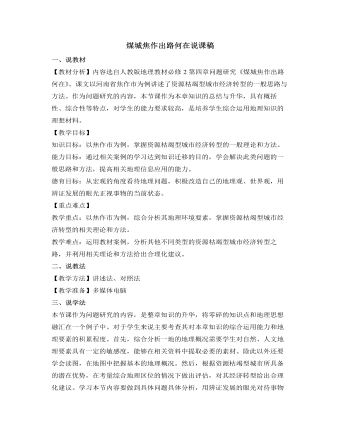
人教版高中地理必修2煤城焦作出路何在说课稿
分析过焦作市的地理概况和产业优势后,就需要针对由于资源枯竭所带来的问题提出合理化的建议。既然是谈经济转型,就应该将话题的范围明确在这一领域内。通过材料3的相关内容,我们了解到焦作市需要在产业结构调整、培育新的优势产业、增强综合竞争力等三个整改方针上下功夫。因而引导学生针对优势与不足提出建议,以三个整改方针为基准,衡量建议的可行性是锻炼学生解决此类问题的有效途径。在此我将教会学生的是解决问题方法而非案例的内容,正所谓“授之以鱼,不如授之以渔”。接下来针对学生的建议和教材资料分析所罗列的10点整改思路,由学生自由发言提出看法,通过教师的指导和学生的讨论,进而确定经济转型建议的具体方案。最后注意将建议与产业优势相对照,看建议是否都是围绕着产业优势而提出的,这样做会加深学生的印象,通过建议和优势的对应关系,将不难找出此类问题的解题思路。
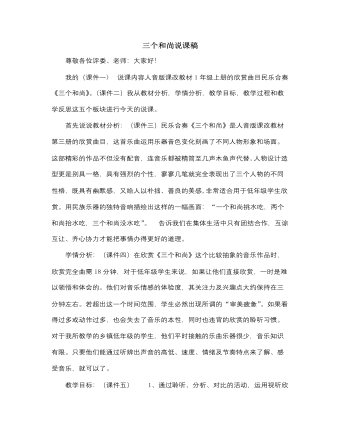
人音版小学音乐一年级上三个和尚说课稿
3.请几组同学表演这几个的场面,其他同学做评委,从模仿表演中享受学习音乐的快乐。五.课堂小结 (阶段目标:以“我的收获”(课件十)帮助学生总结所学内容,知道音乐中,不同的音乐要素可以表现不同的人物、场面)课后反思:(课件十一)在本节音乐欣赏教学中,我坚持以“听”为核心(因为音乐是一门听觉艺术),让学生“带着问题听”、“想着听”、“动着听”、“演着听”等多元化的“听”的形式。一系列“听”的任务不仅提高学生的注意力,而且提高学生“听”的兴趣与“听”的质量。而且我创造和谐的课堂气氛,积极引导学生把对音乐的内心感受大胆地用语言表达出来,让学生主动参与音乐快乐学习的实践中去,创建出有利于学生发展的生动活泼的音乐课堂情景,让学生的了解音乐,感受音乐,融入音乐。

